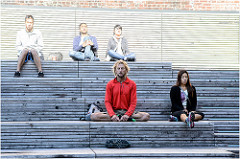By J. MALCOLM GARCIA
1.
I imagine it this way. Gypsy awakens from a restless sleep, stretches. Hears his muscles and bones crack, sees how his curtains absorb the light
of a late San Francisco afternoon, and at that moment decides to start drinking again.
He doesn’t remember having a booze dream, just woke up and decided: Today is the day I’m going to get fucked up. Something clicks into place. Thank God, it’s been decided.
For days he had found it hard to sit still, hard to sleep. His body ached from the weight of his bitterness. He tried to read some of his old text books on alcoholism and its treatment, tried to take pleasure in his term papers and the comments scrawled in red, Nice insight! and Excellent observation! but those evening extension classes at Berkeley had been nothing but a betrayal, an illusion of accomplishment, and he tossed the books and his notepads across the room with a rage that kept him awake at night. He had done everything he should, and still he was denied what he deserved.






 Portrait of Charles-Désiré Norry (1796-1818), 1817
Portrait of Charles-Désiré Norry (1796-1818), 1817



